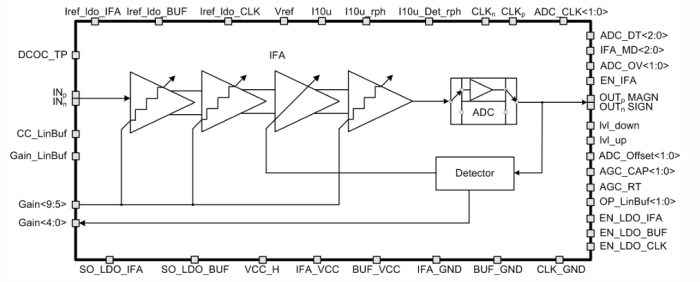IFA consists of 4-stage amplifier with tunable gain, AGC system, linear output buffer for differential analog output, analog-digital converter for digital output and a detector of output level.
The amplifier has differential inputs and outputs, and consists of 4 stages. Gain is sequentially reduced from the last stage to the first stage. This method allows to keep a low noise figure in wide gain range.
The output voltage maintained by AGC system at differential load 200 Ohm:
- for sinusoidal signal is 200 mV (p-p);
- for noise signal is 480 mV (p-p).
The block is fabricated on AMS035 BiCMOS 0.35 um technology
0.8 to 25 MHz Intermediate-frequency amplifier
Overview
Key Features
- AMS035 BiCMOS 0.35 um
- Wide gain range (0…64 dB)
- Low group delay time ripple vs. frequency and gain
- Analog and digital output modes
- Built-in AGC detector with internal capacitor
- Built-in DC offset compensation mode in each stage and in the output buffer
- AGC detector threshold adjustment in the digital mode
- Portable to other technologies (upon request)
Block Diagram

Applications
- Receivers
- Navigation systems
Deliverables
- Schematic or NetList
- Abstract model (.lef and .lib files)
- Layout view (optional)
- Behavioral model (Verilog)
- Extracted view (optional)
- GDSII
- DRC, LVS, antenna report
- Test bench with saved configurations (optional)
- Documentation
Technical Specifications
Short description
0.8 to 25 MHz Intermediate-frequency amplifier
Vendor
Vendor Name
Foundry, Node
AMS BiCMOS 0.35 um
Maturity
silicon proven
Availability
Now